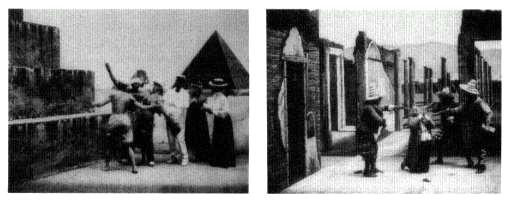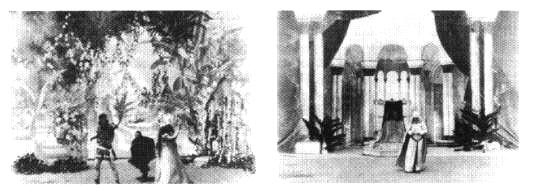The Legacy of Exhibitor-Dominated Cinema
Although Porter was manager of the Edison studio and a successful filmmaker, he continued to project films at Edison charities and other special occasions.[141] This residual role was manifested on another level: the legacy of exhibitor-dominated cinema continued to influence the methods of production and representation inside the Edison Manufacturing Company. Tension continued to exist between the shot and the complete subject as the basic unit of film production, although the larger unit was primary in an increasing number of instances.
The rapid shift in responsibility for exhibition from distributor to theater further reinforced the decline of the exhibitor's editorial role. Editorial control was centralized principally in the production companies, while exchanges purchased predominantly longer subjects and programmed them with a few additional shorts to fill a 1,000-foot reel. While exchanges and most exhibitors were happy to purchase How a French Nobleman. . . in its entirety, the Edison firm also offered prospective purchasers the opportunity to buy individual scenes. In 1905 showmen purchased four shots of the premise-establishing scene at Grant's Tomb, five of the denouement, and fewer copies (one, two, or three) of the chase scenes—indicating that a few exhibitors, even in 1905, were still resisting the trend toward standardization and editorial control by the production companies.[142] Although showmen bought the entire film in the vast majority of cases, the How a French Nobleman. . . narrative was constructed in such a way
Spoofing the travelogue: European Rest Cure.
that the film could be expanded or contracted by the simple addition or elimination of chase scenes. Such a structure continued earlier methods of filmic organization.[143]
The legacy of exhibitor-dominated cinema also affected the making of European Rest Cure . Begun in July 1904, but not copyrighted until September 1st, European Rest Cure was an elaborately produced film with many studio sets. This spoof on the travelogue follows an American tourist across Europe and the Middle East on a "rest cure" in which one physically or emotionally wrenching disaster follows another. Foreign locales were actually pasteboard sets of pyramids, Roman ruins, and a French cafe, while additional scenes were shot at the docks as the tourist leaves and returns. Porter combined this original material with footage of S.S. "Coptic" Running Against the Storm , taken by James White on his Pacific voyage in 1898, and Pilot Leaving "Prinzessen Victoria Luise" at Sandy Hook , taken by White in late 1902. Another shot was excerpted from Sky Scrapers of New York from the North River , which James Smith had filmed in May 1903. The short films incorporated into this longer feature could still be purchased individually: one or two were used by Lyman Howe for a program he assembled, Detailed Scenes of a Trans-Atlantic Voyage from New York to Southampton .[144]
As with A Romance of the Rail, European Rest Cure evolved out of the travel genre and was part of the shift toward filming dramatic material. Once again, Porter took a "documentary" genre and reworked it as a comedy "feature" with a character other than the narrator/tour director to act as a unifying element. The film parodies the format of many nineteenth-century travel lectures, which used materials from different sources and combined scenes taken on location with others photographed in the comfort and artifice of the studio. Fun is poked at the romantic aura of travel perpetuated by exhibitors who
Capture of "Yegg" Bank Burglars: the "Yeggs" shoot it out and escape across a lake.
were themselves often beholden to railroad and shipping companies. As before, Porter was working effectively within a well-established genre. In this case, however, the continuing popularity of the traditional form may have created audience resistance to the spoof and resulted in modest sales, for the title sold only twenty-three prints in the year and a half after its release.
Following European Rest Cure , Porter worked on Capture of "Yegg" Bank Burglars , another production in which the exhibitor's former editorial role remains apparent. Filmed between August l5th and September 10th, this headliner was motivated by Lubin's The Bold Bank Robbery , first advertised in the New York Clipper on August 13th. Thus it continued the pattern of imitating other companies' successes.[145] Porter's film reenacted "the Criminal life and methods of the 'Hobo' Bank, Vault and Safe Burglar as described in paper read by William A. Pinkerton of Pinkerton's National Detective Agency before the Annual Convention of the International Association of Chiefs of Police, St. Louis, MO.; June 6 to 11, 1904."[146] Using the speech as a foundation, along with additional information and suggestions by Robert A. Pinkerton and G. S. Doherty of the Pinkerton agency, Porter produced a film within the crime genre he had first explored with The Great Train Robbery . Compared to the earlier film, Porter simplified the narrative construction and generally avoided the problematic returning to earlier points in time and the shifting back and forth between different lines of action.[147] At the same time, additional elements were added: the robbery is planned and scouted before it is put into action, and the chase elaborated.
There are two different versions of Capture of "Yegg" Bank Burglars , however. The first survives in the Library of Congress Paper Print Collection. On August 27th, Porter and Abadie (in his last documented appearance as an Edison cameraman) filmed Railroad Smash-up outside of Boston. While this human-interest news film of a planned train collision was soon released as a separate subject, Porter also used it to end his bank burglary film in a spectac-
Parsifal: Sets came from a theatrical production,
but the film was intended to be accompanied by a lecture.
ular fashion. In a transitional scene, the burglars were shown mounting a locomotive and making good their escape. The next scene is the smash-up shot at Revere Branch, Massachusetts. The camera pans with a quickly moving locomotive, which collides with one coming from the other direction. As with European Rest Cure , actuality footage was put into a narrative context and given a new meaning.
The second version, the one eventually advertised in the Edison catalog, replaced the train collision and transitional scene with four scenes copyrighted separately as Rounding up the Yeggmen . They showed the burglars' capture by undercover police agents. Although the Library of Congress ending is more spectacular, its radical departure from Pinkerton's speech may have been unacceptable. Nevertheless, some prints of the earlier version were almost certainly sold.[148] It seems possible that some customers had a choice of endings. The integration of news material into a dramatic subject, the use of different endings: these syncretic procedures were influenced by Porter's experiences as an exhibitor.
Porter's next film was copyrighted as Nervy Nat Kisses the Bride , then sold as "Weary Willie" Kisses the Bride .[149] In this three-shot comedy, which recalls Porter's What Happened in the Tunnel , a tramp takes advantage of a spat between bride and groom to sneak a kiss—and be thrown off the train for his efforts. Set in a train station, inside a train, and on the tracks, this film could either be integrated by the exhibitor into a program of railway scenes or shown in a variety format. Here the exhibitor's editorial role was still implicitly acknowledged.


